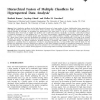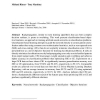TMM
2002
14 years 7 months ago
2002
Modeling spatial context (e.g., autocorrelation) is a key challenge in classification problems that arise in geospatial domains. Markov random fields (MRF) is a popular model for i...
PAA
2002
14 years 7 months ago
2002
: Many classification problems involve high dimensional inputs and a large number of classes. Multiclassifier fusion approaches to such difficult problems typically centre around s...
JMLR
2002
14 years 7 months ago
2002
This paper describes a text chunking system based on a generalization of the Winnow algorithm. We propose a general statistical model for text chunking which we then convert into ...
TSMC
2008
14 years 7 months ago
2008
In genetic programming (GP), evolving tree nodes separately would reduce the huge solution space. However, tree nodes are highly interdependent with respect to their fitness. In th...
PRL
2006
14 years 7 months ago
2006
Regularized linear classifiers have been successfully applied in undersampled, i.e. small sample size/high dimensionality biomedical classification problems. Additionally, a desig...
NPL
2006
14 years 7 months ago
2006
Hierarchical Incremental Class Learning (HICL) is a new task decomposition method that addresses the pattern classification problem. HICL is proven to be a good classifier but clos...
ML
2006
ACM
14 years 7 months ago
2006
ACM
Backpropagation, similar to most learning algorithms that can form complex decision surfaces, is prone to overfitting. This work presents classification-based objective functions, ...
FSS
2008
14 years 7 months ago
2008
In the field of classification problems, we often encounter classes with a very different percentage of patterns between them, classes with a high pattern percentage and classes w...
CORR
2010
Springer
14 years 7 months ago
2010
Springer
Although backpropagation ANNs generally predict better than decision trees do for pattern classification problems, they are often regarded as black boxes, i.e., their predictions c...
CORR
2010
Springer
14 years 7 months ago
2010
Springer
Artificial neural networks (ANNs) have been successfully applied to solve a variety of classification and function approximation problems. Although ANNs can generally predict bett...


